Hazard Xi,N,Xn
Risk R36/37/38
Safety
Hazard Codes:
Xn: Harmful .gif)
Xi: Irritant .gif)
N: Dangerous for the environment .gif)
Risk Statements about Decahydroquinoline (2051-28-7):
R20/21/22 Harmful by inhalation, in contact with skin and if swallowed.
R34 Causes burns.
Safety Statements about Decahydroquinoline (2051-28-7):
S26 In case of contact with eyes, rinse immediately with plenty of water and seek medical advice.
S36/37/39 Wear suitable protective clothing, gloves and eye/face protection.
S45 In case of accident or if you feel unwell, seek medical advice immediately (show the label where possible).
Attentions:
1. Storage: Store in a tightly closed container. Store in a cool, dry, well-ventilated area away from incompatible substances.
2. Handling: Wash thoroughly after handling. Remove contaminated clothing and wash before reuse. Use with adequate ventilation. Avoid contact with eyes, skin, and clothing. Keep container tightly closed. Avoid ingestion and inhalation.
3. Personal Protection: Eyes: Wear appropriate protective eyeglasses or chemical safety goggles as described by OSHA's eye and face protection regulations in 29 CFR 1910.133 or European Standard EN166. Skin: Wear appropriate protective gloves to prevent skin exposure. Clothing: Wear appropriate protective clothing to prevent skin exposure.
4. Fire Fighting: Wear a self-contained breathing apparatus in pressure-demand, MSHA/NIOSH (approved or equivalent), and full protective gear. During a fire, irritating and highly toxic gases may be generated by thermal decomposition or combustion. Use water spray to keep fire-exposed containers cool. Water may be ineffective. Material is lighter than water and a fire may be spread by the use of water. Extinguishing media: Water may be ineffective. Use agent most appropriate to extinguish fire. Cool containers with flooding quantities of water until well after fire is out. In case of fire use water spray, dry chemical, carbon dioxide, or appropriate foam.

